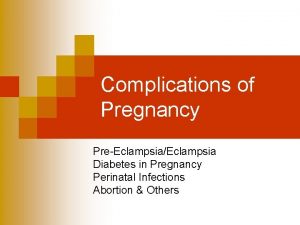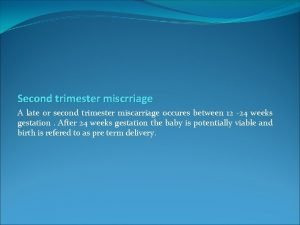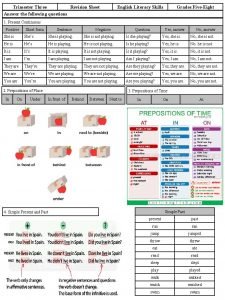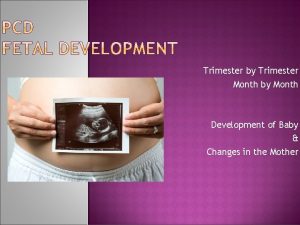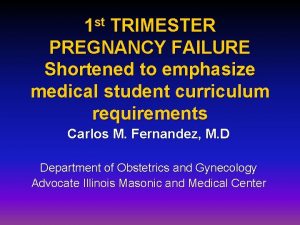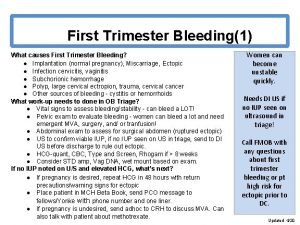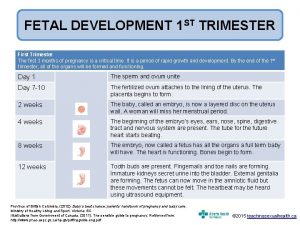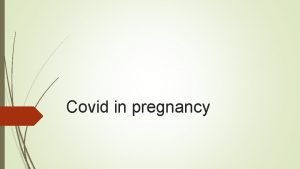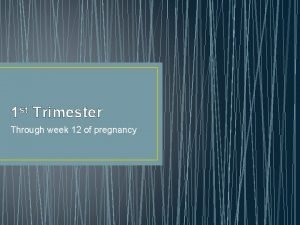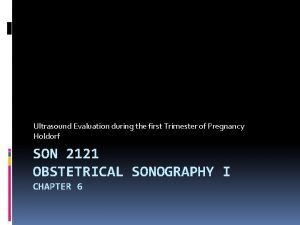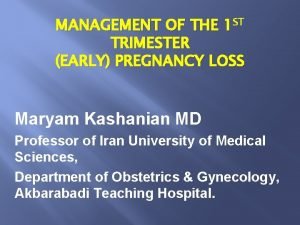1 st TRIMESTER PREGNANCY FAILURE Shortened to emphasize





































- Slides: 37

1 st TRIMESTER PREGNANCY FAILURE Shortened to emphasize medical student curriculum requirements Carlos M. Fernandez, M. D Department of Obstetrics and Gynecology Advocate Illinois Masonic and Medical Center

ULTRASOUND DIAGNOSIS OF INTRAUTERINE PREGNANCY

Diagnosis of IUP 1. 2. 3. 4. “Double decidual sign” at 4½ to 5 wks Gestational sac + yolk sac at 5 wks (a definitive sign of IUP) GS + yolk sac + embryo at 5½ to 6 wks CRL >5 mm – fetal cardiac activity present Seeber BE and Barnhart KT. Obstet Gynecol 2006; 107: 339 -413

Tips for Students n IUP=intrauterine pregnancy n n n Could include a live intrauterine pregnancy, a threatened abortion, an inevitable abortion, an incomplete abortion, or a missed abortion Does not include ectopic pregnancy, completed miscarriage, or a molar pregnancy Gestational age The age of the pregnancy in weeks since the last menstrual period n About 2 weeks longer than the embryonic age n

Tips for Students n n Try to memorize the gestational ages at which the markers of an intrauterine pregnancy appear…. But more importantly, you should understand what is required to confirm an intrauterine pregnancy n n This is how we rule out ectopic pregnancies and molar pregnancies If there is any possibility of an intrauterine pregnancy, you cannot give methotrexate or cytotec you could cause an elective abortion

The first sign of an intrauterine pregnancy GESTATIONAL SAC DOUBLE DECIDUAL SIGN

First sign of IUP: double decidual sign n n Earliest finding is the “double decidual sign” (arrows) seen around 4½-5 wks gestation initially eccentric in location It excludes pseudogestational sac (free fluid or blood within endometrium)


Gestational Sac (confirmed by double decidual sign) n n n Grows 1 mm per day Usually seen by 4 ½ to 5 weeks of gestation Discriminatory ß-h. CG with TVUS (the level of ßh. CG above which you should be able to see a gestational sac on transvaginal ultrasound): n n Usually quoted 1000 - 2000 ß-h. CG IU/L At AIMMC, we use 1500 IU/L

Gestational Sac n Discriminatory ß-h. CG with transvaginal ultrasound : n n 1000 - 2000 ß-h. CG IU/L Discriminatory ß-h. CG with transabdominal ultrasound: n ≥ 6500 ß-h. CG IU/L Bhatt & Dogra, Radiol Clin N Am 45 (2007) 549 -560

The gestational sac diameter is used to calculate gestational age Long axis Short axis

Second sign of intrauterine pregnancy YOLK SAC

Second sign of IUP: Yolk Sac v v v First structure visualized within the gestational sac Round , bright ring A definitive sign of IUP Involutes after 11 weeks Can be seen half a week before normal embryo is seen When enlarged (“hydropic”), solid or duplicated, it is a very poor prognosis sign

Third sign of intrauterine pregnancy FETAL POLE

Third sign of IUP: GS + yolk sac + embryo n n GS + yolk sac + fetal pole at 5½ to 6 wks The fetal pole (arrow) is better seen on the zoomed in image GS grows 1 mm/day Embryo grows 1 mm/day

Fourth sign of intrauterine pregnancy CARDIAC ACTIVTIY

Fourth sign of IUP: GS + YS + embryo + cardiac activity n n Double decidual sign +yolk sac+ fetal pole +cardiac activity Cardiac activity confirms a live intrauterine pregnancy (rules out a miscarriage) Cardiac activity is usually detected at 5 ½ to 6 weeks from last menstrual period CRL ≥ 5 mm – fetal cardiac activity present

BHCG AND PROGESTERONE IN EARLY PREGNANCY

Serum concentrations of ß-h. CG in 443 normal pregnancies ß-h. CG is first detected in maternal serum 6 to 9 days after conception. The levels rise in a logarithmic fashion, peaking 8 to 10 weeks after the last menstrual period, followed by a decline to a nadir at 18 weeks, with subsequent levels remaining constant until delivery Second International Standard ß-h. CG Braunstein G D, et al. Am J Obstet Gynecol 1976; 126: 678 -81.

Serial ß-h. CG The doubling time for a normal IUP is 2 days n ß-h. CG peaks at ~10 weeks gestation n n It can get as high as 100, 000 IU/L Doubling of ß-h. CG is less reliable after 10 weeks gestation. At this time, pregnancy is better evaluated with U/S n 15% of normal IUPs can demonstrate an abnormal rise of ß-h. CG n Kadar N, et al. Obstet Gynecol 1981; 52: 162 -6

ß-h. CG up to 10000 m. IU/ml The minimal rise in ß-h. CG for a viable pregnancy is 53% in 48 hours n The minimal decline of a spontaneous abortion is 21 -35% in 48 hours n A rise or fall in serial ß-h. CG values that is slower than this is suggestive of an ectopic pregnancy n Seeber BE and Barnhart KT. Obstet Gynecol 2006; 107: 339413

Hypothetical illustration of the rise, or fall, of serial h. CG values in women with an EP 53% 21 -35% Seeber BE and Barnhart KT. Obstet Gynecol 2006; 107: 339 -413

SPONTANEOUS ABORTION: BACKGROUND, ETIOLOGY

Spontaneous abortion or miscarriage n Spontaneous abortion is a fetal loss before 20 weeks gestation n 80% of miscarriages occur in the first trimester (first twelve weeks) n Biochemical pregnancy: n n A woman has a positive pregnancy test, but does not miss a period (her period might come a few days late) The pregnancy has miscarried very early (~3 wks gestation) Ferri: Ferri's Clinical Advisor 2012,

Background n n n Miscarriage is the most common serious pregnancy complication affecting approximately 30% of biochemical pregnancies and 11– 20% of clinically recognized pregnancies The diagnosis of miscarriage is made most commonly by trans-vaginal ultrasound (TVS) assessment After a diagnosis of miscarriage, half of women undergo significant psychological effects Cecilia Bottomley, Tom Bourne. Diagnosing miscarriage. Best Practice & Research Clinical Obstetrics & Gynecology 2009; 23: 463 -77

Etiology v Approximately 50– 60% of first-trimester spontaneous abortions have karyotype abnormalities Igor N Lebedev, Nadezhda V Ostroverkhova, Tatyana V Nikitina, Natalia N Sukhanova and Sergey A Nazarenko. Features of chromosomal abnormalities in spontaneous abortion cell culture failures detected by interphase FISH analysis. European Journal of Human Genetics 2004; 12: 513– 20

Etiologies n The most frequent type of chromosomal abnormalities detected are: 1. Autosomal trisomies ─ 52 % 2. Monosomy X ─ 19 % 3. Polyploidies ─ 22 % 4. Other ─ 7 % Hsu, LYF. Prenatal diagnosis of chromosomal abnormalities through amniocentesis. In: Genetic Disorders and the Fetus, 4 th ed, Milunsky, A (Ed), The Johns Hopkins University Press, Baltimore 1998. p. 179

CLASSIFICATION OF MISCARRIAGE

Clinical classification of spontaneous abortion Laifer-Narin SL. Ultrasound for Obstetrics Emergencies. Ultrasound Clin. 2011; 6: 177 -193 Type Definition Threatened abortion Vaginal bleeding during the first 20 weeks of pregnancy and no evidence of cervical dilation. <50% of threatened abortions will progress to loss of pregnancy. Missed abortion Intrauterine demise of the embryo without either vaginal bleeding or expulsion of the products of conception. Includes both an embryo with no heart tones (>7 mm) or an empty gestational sac (>20 mm). Incomplete abortion Vaginal bleeding with dilation of the cervix and partial expulsion of products of conception. Complete abortion Vaginal bleeding with expulsion of all of the products of conception. Inevitable abortion Abortion in progress with cervical dilation but the products of conception have not been expelled.

Differential Diagnosis of Threatened Abortion 1. Undetermined or physiologic 2. 3. 4. 5. 6. (implantation related) Ectopic pregnancy Sub-chorionic bleed, found in ~20% of threatened Ab Gestational trophoblastic disease (molar pregnancy) Impending spontaneous miscarriage Cervix, vaginal or uterine pathology

This section is too in-depth for most medical students; read it for background, but you don’t necessarily have to memorize! ULTRASOUND DIAGNOSIS OF MISCARRIAGE

Different organizations use different cutoffs to diagnose miscarriage… COMPARISON OF INTERNATIONAL CRITERIA

How to define miscarriage using ultrasound-comparing and contrasting national guidelines Royal College of Obstetricians and Gynaecologists. The Management of Early Pregnancy Loss. Green-Top Guideline No. 25. October 2006 n Miscarriage: v Mean sac diameter greater than 20 mm and no embryonic contents, or v Embryo crown-rump length > 6 mm with no heart beat, or v If sac remains empty after at least one week or still no cardiac activity 1 week after initial ultrasound

How to define miscarriage using ultrasound-comparing and contrasting national guidelines The Institute of Obstetricians and Gynaecologists Royal College of Physicians of Ireland Transvaginal Ultrasound Embryo > 7 mm No cardiac activity Miscarriage Gestational sac > 20 mm No embryo or yolk sac Miscarriage

What is the evidence to support the cut-offs used to diagnose miscarriage? UOG 2011 November, Jeve Y et al. n n n Systematic review of ultrasound diagnosis of miscarriage Problems: studies are 15– 20 years old, small study numbers, and various cut-off values used (4– 6 mm for CRL, 13– 25 mm for MSD), making pooling of data impossible Best (most specific) criteria appeared to be MSD > 25 mm with a missing embryo or MSD > 20 mm with a missing yolk sac These criteria had a 95% CI of 0. 96– 1. 00, therefore up to 4 out of 100 diagnoses of early fetal demise may be wrong. A single incorrect diagnosis of miscarriage is one

Abdallah Y, et al. Limitations of current definitions of miscarriage using mean gestational sac diameter and crown–rump length measurements: a multicenter observational study. Ultrasound Obstet Gynecol 2011; 38: 497 – 502 n n n Prospective multicenter study 1060 patients of IPUV Conclusions In order to minimize the risk of a false-positive diagnosis of miscarriage the following cut-off could be introduced n Empty gestational sac or sac with a yolk sac but no embryo seen with MSD >25 mm n Embryo with an absent heartbeat and CRL > 7 mm

Summary v Significant interobserver variability may be associated with a misdiagnosis of miscarriage v This could result in interventions (D&C, misoprostol use) that could harm a viable pregnancy Current national guidelines should be reviewed to avoid inadvertent termination of wanted pregnancy v Large prospective studies with agreed reference standards are urgently required v
 Trimester breakdown
Trimester breakdown Spotting in pregnancy
Spotting in pregnancy Non conducted pac ecg
Non conducted pac ecg Supparerk vision center
Supparerk vision center Ductile failure example
Ductile failure example Trimester classification
Trimester classification Name that
Name that Unsw academic calendar 2019
Unsw academic calendar 2019 Trimester period
Trimester period In your answer sheet answer the following questions
In your answer sheet answer the following questions Semester vs trimester
Semester vs trimester Advantages of trimester system
Advantages of trimester system Trimester graphic organizer
Trimester graphic organizer Trimester 1 2 3
Trimester 1 2 3 Types of unshortened cakes
Types of unshortened cakes Shortened words
Shortened words This baked product is the richest and sweetest of all.
This baked product is the richest and sweetest of all. Vastikkeet
Vastikkeet General molecular formula of alkene
General molecular formula of alkene Truth tree examples
Truth tree examples Arrival chronology in hotels
Arrival chronology in hotels Together shortened
Together shortened A shortened form of the ledger is called a
A shortened form of the ledger is called a Hamming code 15 11 example
Hamming code 15 11 example As the distance between ions in an ionic bond is shortened
As the distance between ions in an ionic bond is shortened Types of unshortened cakes
Types of unshortened cakes A well made shortened cake will have
A well made shortened cake will have Shortened cake and unshortened cake
Shortened cake and unshortened cake Cite at least 2 examples of shortened and unshortened cakes
Cite at least 2 examples of shortened and unshortened cakes Personal process model
Personal process model You a worksheet to emphasize certain entries
You a worksheet to emphasize certain entries Situational theory of leadership emphasize
Situational theory of leadership emphasize Simile from stereo hearts
Simile from stereo hearts High-context cultures emphasize nonverbal messages.
High-context cultures emphasize nonverbal messages. Accentuate definition
Accentuate definition Trait theories
Trait theories Emphasize that profitable marketing
Emphasize that profitable marketing The soviet union: what should textbooks emphasize?
The soviet union: what should textbooks emphasize?
